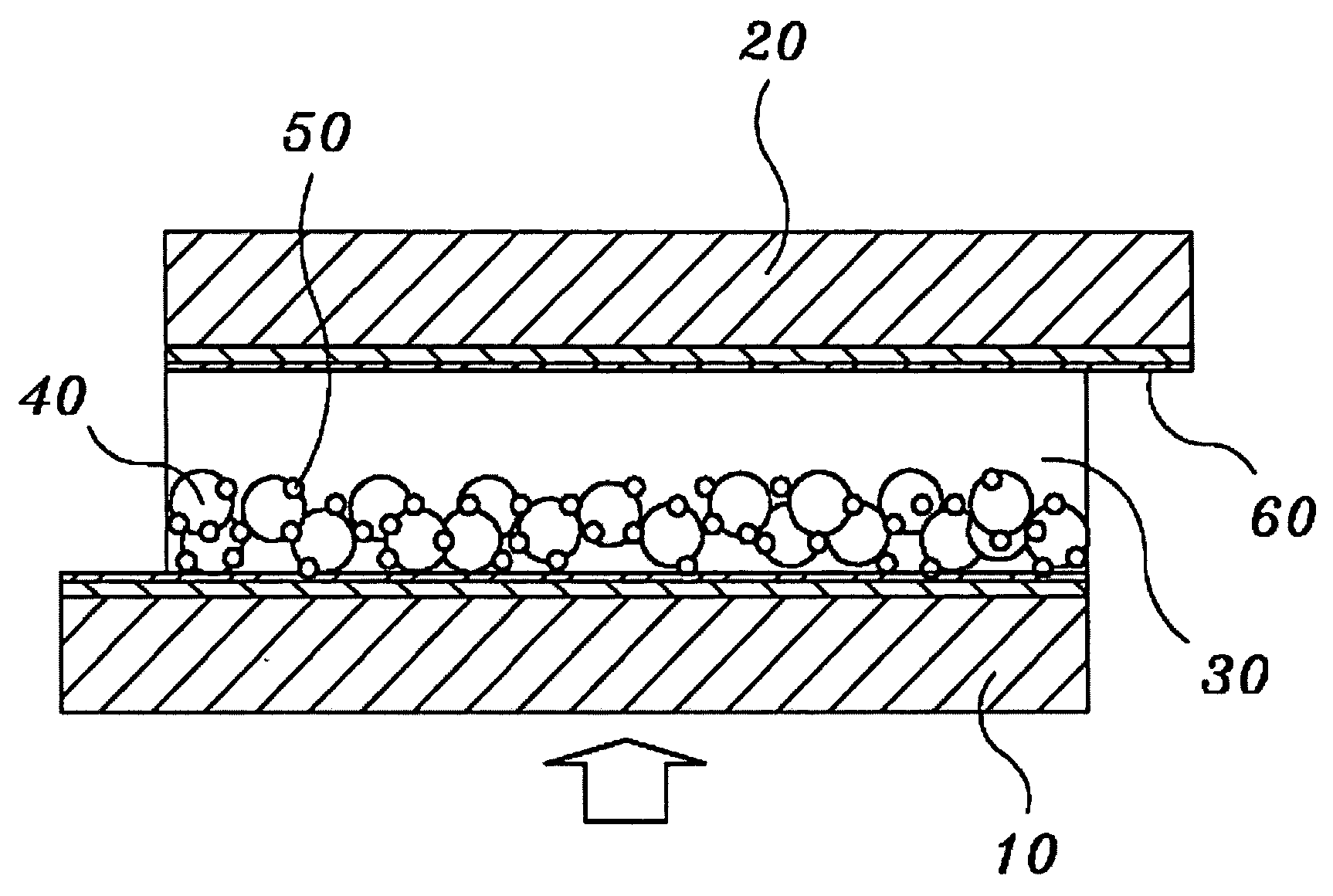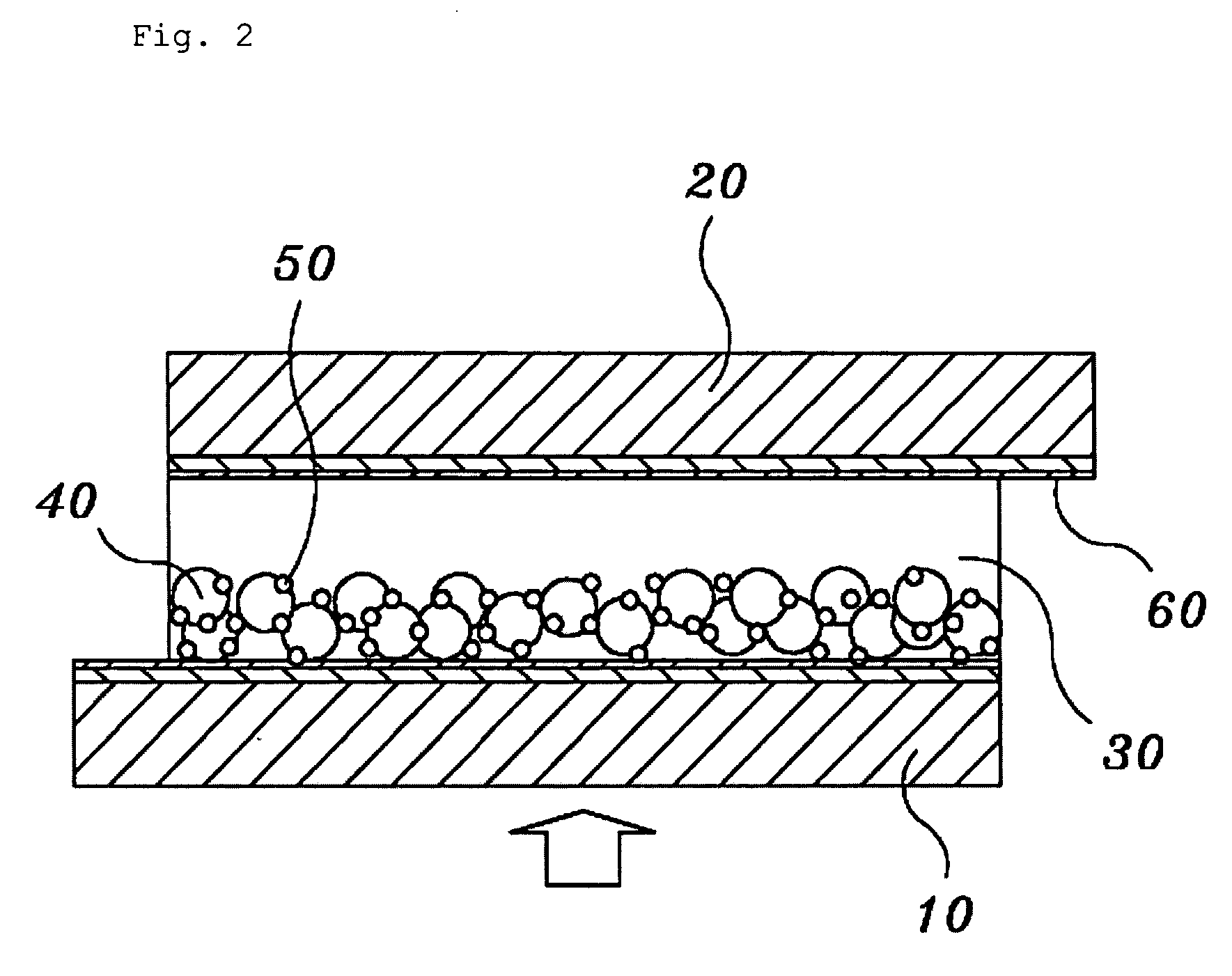Solid state dye-sensitized solar cell employing composite polymer electrolyte
a solar cell and composite polymer technology, applied in the direction of light-sensitive devices, capacitors, electrolytic capacitors, etc., can solve the problems of inability to commercialize, the use of solar cells in long-term stable and commercial applications is very unsuitable, and the electrolyte solution is likely to volatilize, etc., to achieve high energy conversion efficiency
- Summary
- Abstract
- Description
- Claims
- Application Information
AI Technical Summary
Benefits of technology
Problems solved by technology
Method used
Image
Examples
example 1
First Production of a Dye-Sensitized Solar Cell (Single Layer Coating Method)
[0059] Production of a Polymer Electrolyte
[0060] Polyethylene oxide (PEO, Rg=420 Å, Tg=−67° C., Tm=66° C., Aldrich Co.) and polypropylene glycol (PPG, Rg=10 Å, Tg=−73° C., Tm=66° C., Aldrich Co.) in a predetermined ratio (PEO / PPG=4 / 6, weight ratio) were dissolved in 9.5 g of acetonitrile to produce a homogeneous and transparent polymer solution (polymer concentration of 5 wt %). Sodium iodide (NaI, Aldrich Co.) was added to the polymer solution so that a molar ratio of [—O—]:[NaI] was 20:1 ([—O—] means the number of moles of ether groups contained in all polymer chains). An amount of added iodine (I2) was fixed to 10 wt % based on sodium iodide. Thereby, the polymer electrolyte was created.
[0061] Production of the Dye-Sensitized Solar Cell
[0062] After the Polymer Electrolyte Having a Polymer concentration of 5 wt % was cast on a photoelectrode, onto which Ru(dcbpy)2(NCS)2 (Ru 535, Solaronix, Switzerland...
example 2
Second Production of the Dye-Sensitized Solar Cell (Multilayer Coating Method)
[0063] Production of a Polymer Electrolyte
[0064] The polymer electrolyte was produced according to the same procedure as example 1.
[0065] Production of the Dye-Sensitized Solar Cell
[0066] After the polymer electrolyte with a polymer concentration of 5 wt % was cast on a photoelectrode, onto which Ru(dcbpy)2(NCS)2 (Ru 535, Solaronix, Switzerland), acting as an organic dye, was adsorbed, and onto a counter electrode, acetonitrile acting as a solvent was volatilized for 1 min. Next, the polymer electrolyte having a polymer concentration of 5 wt % was concentrated to produce a highly concentrated polymer electrolyte having a polymer concentration of 50 wt %. Subsequently, the highly concentrated polymer electrolyte was cast again on the photoelectrode, and the counter electrode was laminated on the resulting photoelectrode. As in example 1, the dye-sensitized solar cell was interposed between two glass sub...
experimental example 1
[0067] Polyethylene oxide (PEO, Rg=420 Å, Tg=−67° C., Tm=66° C., Aldrich Co.) and polypropylene glycol (PPG, Rg=10 Å, Tg=−73° C., Tm=66° C., Aldrich Co.) in a predetermined ratio were dissolved in 9.5 g of acetonitrile to produce a homogeneous and transparent polymer solution (polymer concentration of 5 wt %). Sodium iodide (NaI, Aldrich Co.) was added to the polymer solution so that a molar ratio of [—O—]:[NaI] was 20:1. An amount of added iodine (I2) was fixed to 10 wt % based on sodium iodide. Thereby, the polymer electrolyte was created.
[0068] The polymer electrolyte solution was coated on a photoelectrode, including a titanium oxide layer, onto which an organic dye was adsorbed, and onto a counter electrode, on which platinum is coated, according to a multilayer coating method, adopting a two-stage coating process, to produce a dye-sensitized solar cell (sample 1). A solvent was completely removed from the solar cell using a vacuum oven for 5 days or more, and an open-circuit ...
PUM
 Login to View More
Login to View More Abstract
Description
Claims
Application Information
 Login to View More
Login to View More - R&D
- Intellectual Property
- Life Sciences
- Materials
- Tech Scout
- Unparalleled Data Quality
- Higher Quality Content
- 60% Fewer Hallucinations
Browse by: Latest US Patents, China's latest patents, Technical Efficacy Thesaurus, Application Domain, Technology Topic, Popular Technical Reports.
© 2025 PatSnap. All rights reserved.Legal|Privacy policy|Modern Slavery Act Transparency Statement|Sitemap|About US| Contact US: help@patsnap.com



